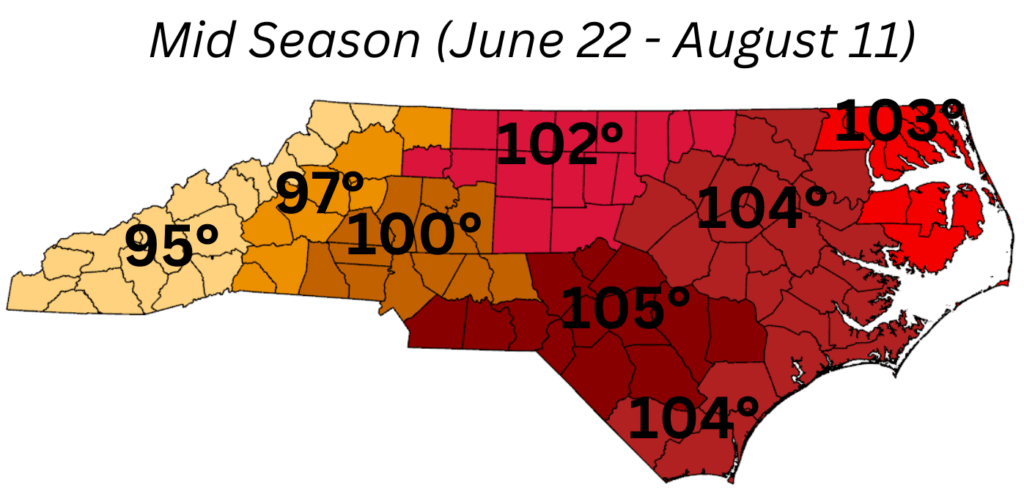Thresholds for Extreme Heat
Extreme heat and extreme heat events occur when temperatures or heat indices surpass specific thresholds. A heat threshold refers to a specific temperature above which environmental conditions are considered extreme or hazardous. These thresholds can be based on air temperatures or other heat stress indicators such as the heat index or Wet Bulb Globe Temperature. Heat thresholds help us understand not just how hot it is, but how the heat might affect us, making it clear when we are facing extreme or hazardous conditions. At temperatures higher than established heat thresholds, negative health impacts begin to occur, and days or periods with these temperatures are considered extreme heat events.
The temperature at which humans begin to experience negative health impacts is different for everyone. That temperature can vary by what temperatures your body is used to, age, pre-existing health conditions, medications taken, and more. Scientists and state and federal agencies typically identify heat thresholds for geographic areas with similar climates, ensuring guidelines are tailored to local conditions and residents’ needs.
Scientists in North Carolina developed these thresholds based on daily maximum heat index, heat-related emergency department visits, and mortality records in North Carolina over the period 2007-2022. Specifically, researchers calculated heat index thresholds for the early heat season (May 1 – June 21), mid-season (June 22 – August 10), and late season (August 11 – September 30) by correlating the maximum heat index of any given day with the corresponding number of heat-related emergency department visits and deaths for that day. They organized this analysis into eight groups of counties. Each grouping includes North Carolina counties with similar climate patterns.
North Carolina’s heat thresholds were developed through a partnership between the State Climate Office of North Carolina, Duke University’s Nicholas Institute for Energy, Environment and Sustainability and the North Carolina Department of Health and Human Services. Partners will update the thresholds on the website as more data become available, ensuring local governments have the most up-to-date thresholds to safeguard their communities against extreme heat. The most recent update took place in Spring 2025. Thresholds are not expected to change more often than every two to three years. Sign up for the State Climate Office Blog or the State Resilience Office’s Spotlight on Resilience monthly e-newsletter to receive a notification when heat thresholds are updated. Sign up for Heat Health Alerts from NCDHHS to receive an alert if the heat index is expected to reach these thresholds for your county.
Refer to the maps and tables below to identify the recommended heat index threshold for your locale.




| Region | Early Season (May 1 – Jun 21) | Mid Season (Jun 22 – Aug 10) | Late Season (Aug 11 – Sep 30) |
|---|---|---|---|
| 1. Southeast | 95ºF | 103ºF | 100ºF |
| 2. North Central | 94ºF | 102ºF | 98ºF |
| 3. Northeast | 95ºF | 104ºF | 101ºF |
| 4. South Central | 95ºF | 100ºF | 98ºF |
| 5. North Coastal Plain | 98ºF | 104ºF | 98ºF |
| 6. Foothills | 92ºF | 97ºF | 94ºF |
| 7. Sandhills | 99ºF | 105ºF | 101ºF |
| 8. Mountains | 85ºF | 94ºF | 90ºF |

Region 1: Southeast
Brunswick
Carteret
Columbus
Craven
Jones
New Hanover
Onslow
Pamlico
Pender
Region 2: North Central
Alamance
Caswell
Chatham
Durham
Forsyth
Granville
Guilford
Orange
Person
Randolph
Rockingham
Stokes
Vance
Warren
Yadkin
region 3: NORTHEAST
Camden
Chowan
Currituck
Dare
Gates
Hertford
Hyde
Pasquotank
Perquimans
Tyrrell
Washington
region 4: South Central
Cabarrus
Catawba
Cleveland
Davidson
Davie
Gaston
Iredell
Lincoln
Mecklenburg
Montgomery
Rowan
Stanly
region 5: North Central Plain
Beaufort
Bertie
Edgecombe
Franklin
Greene
Halifax
Johnston
Lenoir
Martin
Nash
Northampton
Pitt
Wake
Wayne
Wilson
region 6: Foothills
Alexander
Burke
Caldwell
McDowell
Polk
Rutherford
Surry
Wilkes
region 7: sandhills
Anson
Bladen
Cumberland
Duplin
Harnett
Hoke
Lee
Moore
Richmond
Robeson
Sampson
Scotland
Union
region 8: mountains
Alleghany
Ashe
Avery
Buncombe
Cherokee
Clay
Graham
Haywood
Henderson
Jackson
Macon
Madison
Mitchell
Swain
Transylvania
Watauga
Yancey